Latest reviews
You are Maxine “Max” Caulfield. You are 18 years old. You live in Arcadia Bay, a seaside town in the US state of Oregon. You’re a student at a private high school with an arts and science focus. No matter whether you’re at school, at home, or at play, you and your Polaroid camera as inseparable. Perhaps one day your pictures will catch the eye of Mark Jefferson, a famous photographer who teaches at your school?
This is the seemingly ordinary setting of Life is Strange, a narrative adventure game developed by Dontnod Entertainment and published episodically through 2015. The game is played in a third-person 3D view, rendered in an artistic style situated firmly between painterly and photorealistic. While not up to today’s technical standards, the game world is still beautiful and immersive.
Your experience as Max starts with a nightmarish vision of destruction. But it was only a daydream; you’re in school, and Mr. Jefferson is asking you about the technical process that gave rise to the first photographic self-portraits. It’s only after a dramatic encounter with a childhood friend, Chloe Price, that things really get strange. And what is the story behind the disappearance of Chloe’s friend, Rachel Amber?
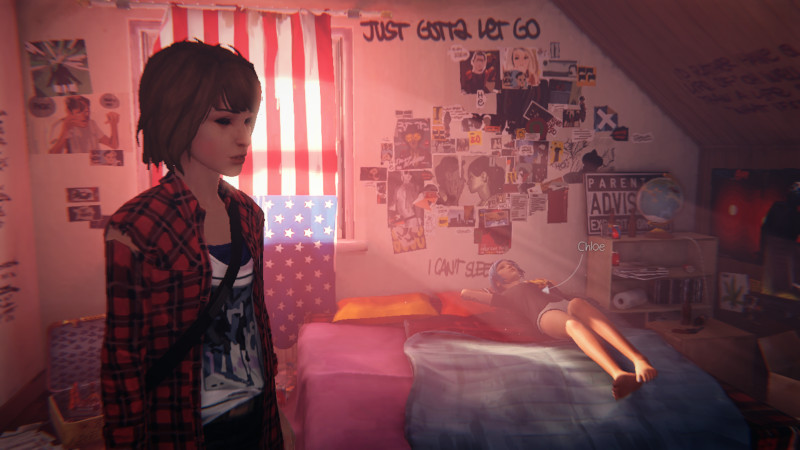
Max in Chloe’s room. The game lets you explore its rich environments at your own pace, taking in every detail if you want to. (Credit: Dontnod Entertainment. Fair use.)
In terms of gameplay, Life is Strange has much in common with classic point-and-click adventure games: You spend a lot of your time exploring, talking to other characters, and solving small puzzles. There’s no unlimited inventory—occasionally a puzzle may involve finding an object and carrying it from one location to another. There is one additional game mechanic (spoilers ahead):
Warning: The text below contains spoilers.
You discover early in the game that you have a limited ability to reverse the flow of time. This often allows you to try different decision paths and compare outcomes. It makes for a world that feels real and responsive (decisions have consequences) without painting you into a corner.
The game is fully voiced, and it’s a joy to poke at objects in the environment and listen to Max reflect on what she sees in the world around her. If you sit down on a bench, you may be rewarded with some additional wide angle camera views and narration. If you prefer to rush through the story, you can do that, too.
Life is Strange is not a perfect game (some scenes overstay their welcome, for example), but I still consider it a masterpiece in interactive storytelling. It’s a joy to explore Arcadia Bay, thanks to the excellent art direction and attention to detail. The wonderful chemistry between Max and Chloe invests the player in both characters.
The first episode of the game is available for free, and you can often pick the whole game up for under $5. Thanks to Feral Interactive, there is an excellent Linux port, as well. If your computer is not a potato and you enjoy narrative adventure games, Life is Strange is one title you won’t want to miss.
Das Miniatur-Wunderland ist nicht einfach nur “Mal-eben-Eisenbahn-schauen”, sondern man merkt an allen Ecken und Enden dass das Team rund um die beiden Macher hier jede Menge Herzblut einfließen lässt. Das geht los bei den unzähligen Taster-Aktionen und endet bei den ganzen versteckten Kleinigkeiten auf der kompletten Anlage. Da geraten die Züge schon fast zur Nebensächlichkeit. Und das will bei einer Modelleisenbahnaalage schon etwas heißen.

Feuerwehr- und Polizeieinsatz an einem Fluß auf der Miniatur-Wunderland Anlage (Eigenes Werk. Lizenz: CC-BY-SA.)

Ausblick auf ein Bahnhofsdiorama in der Anlage (Eigenes Werk. Lizenz: CC-BY-SA.)
Muss ich hier noch mehr schreiben? Ich glaube nicht, denn der Ruf eilt dem Miniatur-Wunderland weit voraus und ist gerechtfertigt. Nur die kleine Kantine, anders würde ich das Restaurant nicht bezeichnen, ist ein kleiner Ausreißer aber kann die Wertung für die Anlage nicht schmälern. Pommes, Schnitzel und Co. gibt es woanders besser aber für den kleinen Hunger ist es O.K.

Nächtlicher Ausblick auf einen kleinen Bahnhof innerhalb der Anlage (Eigenes Werk. Lizenz: CC-BY-SA.)
Schön, neu und informativ sind die drei Schlagworte, die ich für diesen tollen Baumwipfelpfad vergeben würde. Mit einer sehr moderaten Steigung und einer angenehmen Länge ist er für fast alle Besucher geeignet. Unterwegs sind an jeder Plattform Informationstafeln aufgestellt , die über den Wald und seine Bewohner informieren. Und man erhält auch einen Blick von oben in den angrenzenden Wildtierpark. Sehr schön.
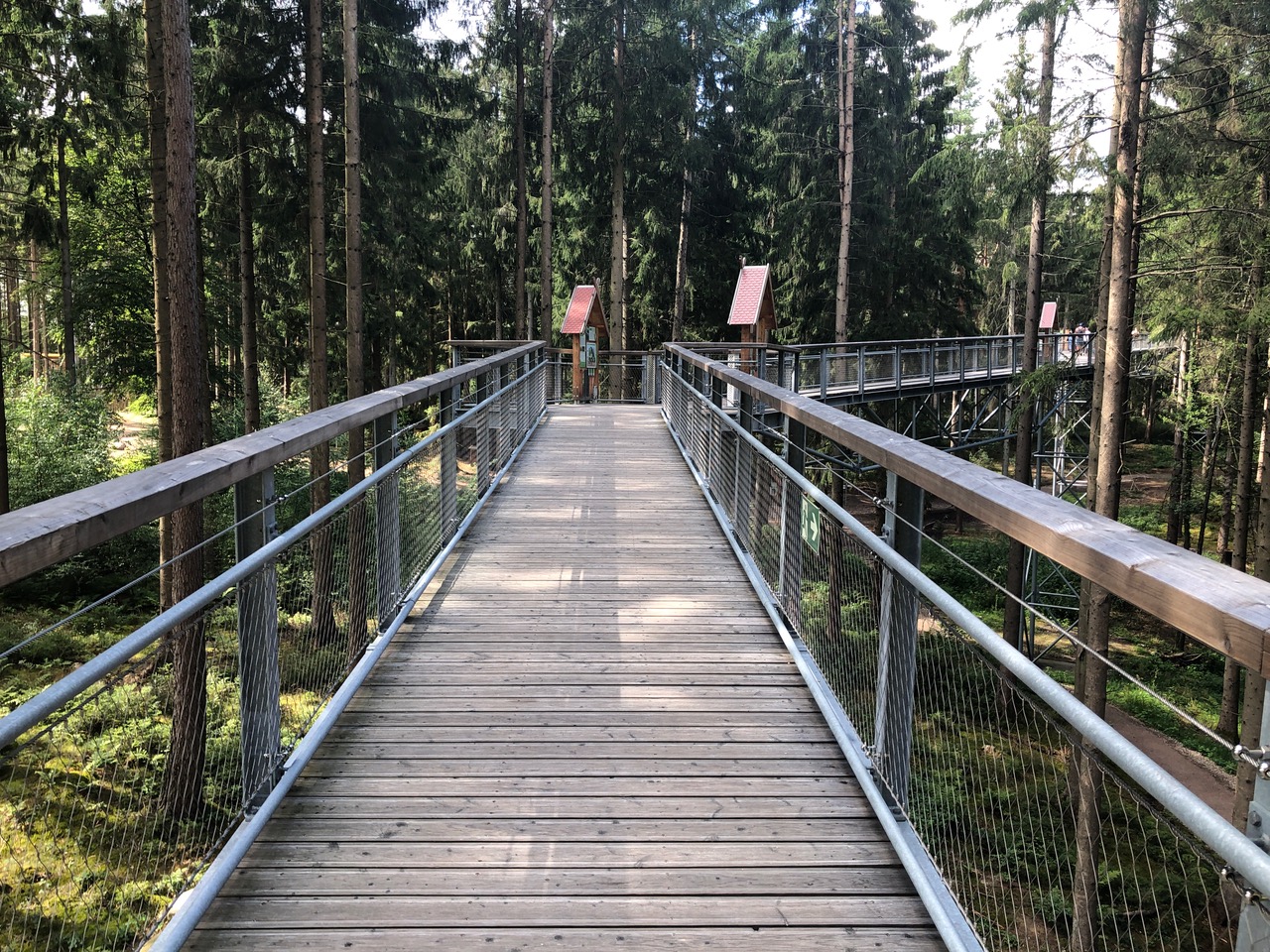
Am Anfang des Pfades (Eigenes Werk. Lizenz: CC-BY-SA.)
Auf dem abschließendem, 40 Meter hohen Turm erhält man einen guten Rundumblick auf die nördliche Lüneburger Heide. Dieser ist für mobilitätseingeschränkte Personen mit einem Lift erreichbar.

Der Turm mit Aussichtsplattform (Eigenes Werk. Lizenz: CC-BY-SA.)
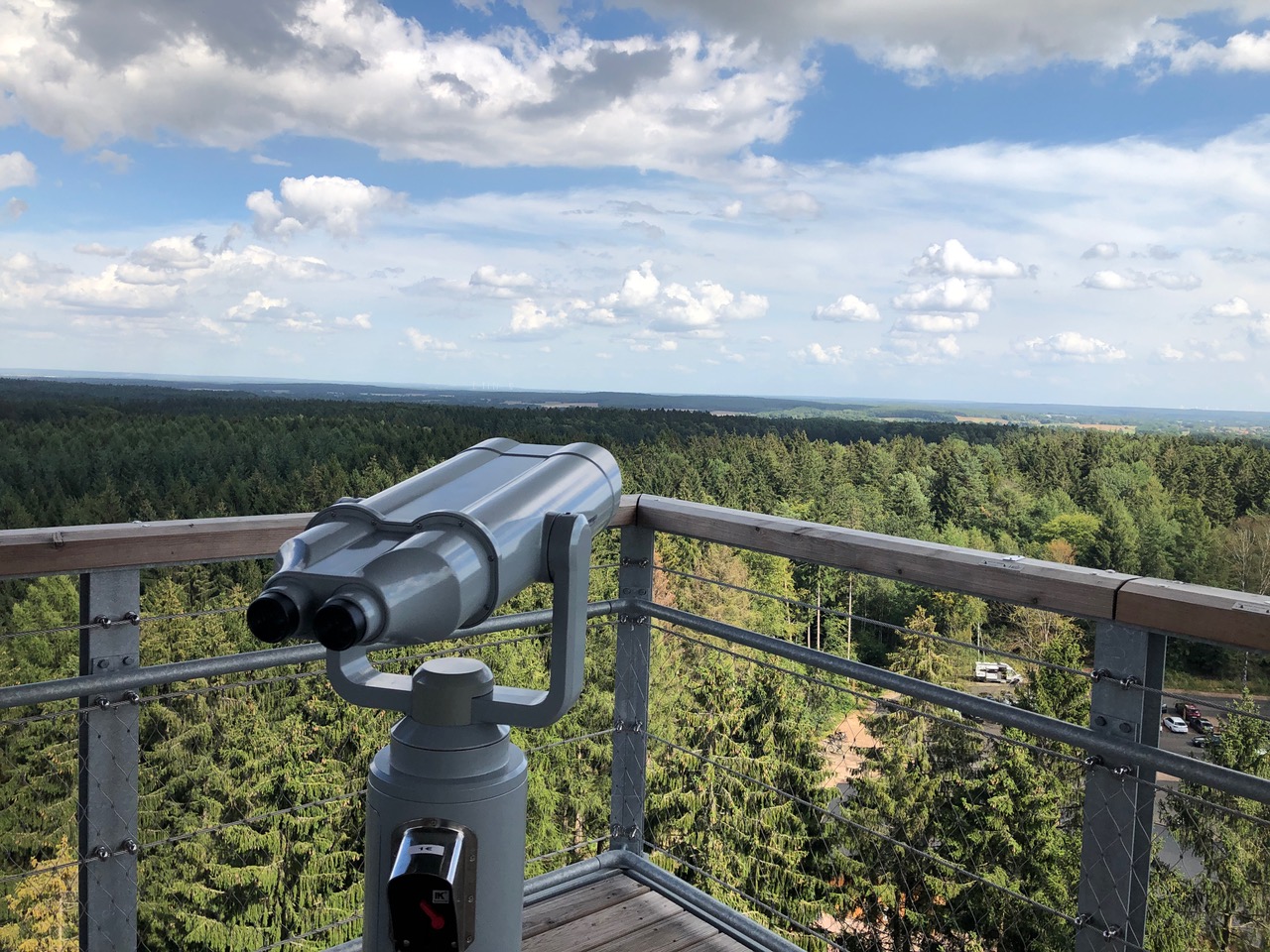
Aussicht vom Turm auf die Nordheide (Eigenes Werk. Lizenz: CC-BY-SA.)
Abschließend kann man sich im Café noch mit einer kleinen Stärkung versorgen.
Alles in allem ein lohnenswertes Ausflugsziel.
FTL: Faster Than Light is now more than 8 years old, but it looked outdated when it was released. Start up the game, and you’re greeted by a low-resolution “LOADING” font, followed by a static title screen featuring a fleet of spaceships parked ominously in front of a planet. The first hint that this game has hidden depths is its memorable title theme, wonderfully evocative of the quietude of space.
The story is told in the simplest terms: You command a lone federation starship that is on the run from the malignant Rebellion (think US Civil War rebels, not Star Wars rebels). Your faster-than-light drive lets you make jumps from one galactic beacon to the next, through several sectors of space that are newly generated on each playthrough. You’re trying to reach the last stronghold of the federation, in order to defeat the Rebel Flagship that’s threatening to destroy it.
Almost every galactic beacon holds a story, or part of one: you run into slavers, traders, pirates, and rebels; you rescue raving madmen and space colonists; you find weaponry and treasure. You often get to make choices, with randomized outcomes. (Stay clear of the Giant Alien Spiders until you know what you’re doing; they are no joke.) At first these scenarios may seem repetitive, but your options will increase depending on your ship and crew.
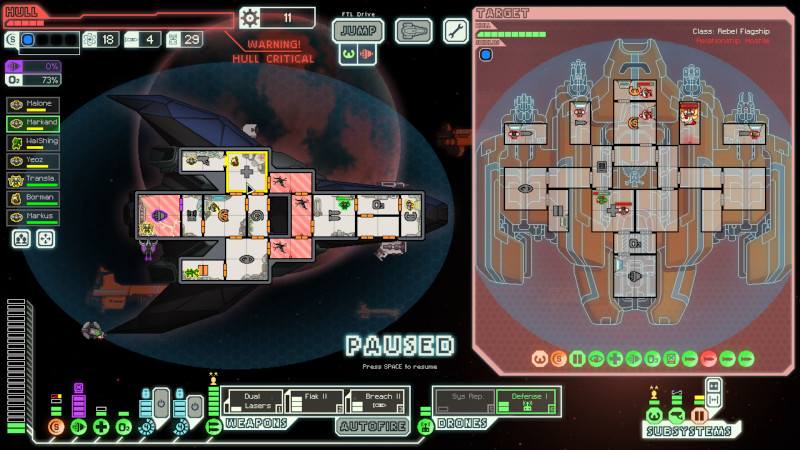
We’re about to get blown to bits by the rebel flagship. (Credit: Subset Games. Fair use.)
Space War!
Many encounters turn into ship-to-ship battles, and that’s where the game really shows its genius. Combat takes place in a real-time-with-pause system that allows you to plan your every move, or to shoot from the proverbial hip. Planning is often advisable, as you may find yourself at a disadvantage even in early encounters.
Each of your ship systems matters, and so does each of theirs. Do they have teleporters, which they’ll use to board your ship and fight your crew? Are you able to hack into their systems, maybe sabotage their shields or their cloaking device? Do they have a flak weapon that will shower your ship with debris? Can you use that asteroid field in your favor?
Some battles are unwinnable (given enough time, you can try to jump away), others will only seem that way to the new player. But it’s almost always fun to figure out what you can do with the cards you’ve been dealt, and to master the ship you’ve chosen to command. There are 10 ships to unlock, and different layouts for each, demanding very different styles of play.
There’s more that could be said about the game’s systems, from ship upgrades to crew recruitment and experience, from drone warfare to oxygen management. In its totality, the game really makes you feel like you’re commanding the crew of a spaceship, and your imagination fills in what the simple graphics cannot.
Death Without Friction
From this description and from screenshots, FTL may appear like a dauntingly complicated game, but this is where the game’s second core strength lies: an absolutely delightful user experience. Move your mouse across the screen, and you’ll get helpful explanations; keyboard and mouse shortcuts are readily available for everything you need often.
How do you increase or decrease the power for the shield systems? In many games, you’d have to click a “+” and “-” button, or drag a slider; in FTL, you left-click to increase, right-click to decrease, or use a keyboard shortcut. And so it is with the rest of the UI: easy to learn, quick to repeat.
I’m a big fan of NetHack (one of the early games that gave us the term “roguelike”), and FTL is the closest equivalent with a space opera setting that I have encountered. The low-friction user experience is a huge part of what makes it all work—it allows you to focus on story and strategy, instead of mechanics that get increasingly annoying through repetition.
Every roguelike tends to claim that “losing is part of the fun”, and in the case of FTL, it’s usually true. Except for when you’re getting hammered by pirates while solar flares are lighting every part of your ship on fire, for the 15th time…
The Verdict
5 stars, no contest. I honestly can’t say enough good things about FTL—it’s a masterpiece of indie game development that has made developer Subset Games an industry legend (their second game, Into the Breach, is very different but no less luminous). The native Linux version works beautifully, and the game is available in 10 languages. There are also amazing-looking mods, but I have not tried them yet.
Even at $10 on GOG, the game offers excellent value (as of this writing, I’ve put some 100 hours of play into it) but it regularly goes on sale for far less. Be aware that this isn’t a fair game—as with most roguelikes, the RNG will put you in impossible situations—and if that tends to prevent you from having fun, you may want to avoid it. For everyone else, FTL continues to be a beacon calling us to assist the federation, just one more time.
Beth Harmon ist ein Schachgenie im Amerika der 1960er und 70er Jahre. Doch damit nicht genug, um diesen Charakter als Außenseiter darzustellen. Sie ist ein Waisenkind, welches in eine zerrüttete Familie adoptiert wird und mit einer Tablettensucht zu kämpfen hat. Klingt sehr Klischeebeladen aber ist durchaus sehr unterhaltsam.
Das Schachspiel lernt sie beim Schulhelfer im Keller und erlangt durch ihr gnadenloses Schachspiel schnell Berühmtheit über das Waisenhaus hinaus. Auch die Spieler des örtlichen Schachclubs sind schnell ausgespielt und die große weite Welt wartet.
Warnung: Der untenstehende Text enthält Spoiler.
Über verschiedene größere Turniere gelangt Beth nach Russland um gegen den Großmeister anzutreten, gegen den sie in einem früheren Spiel verloren hatte.
Die Serie dreht sich hauptsächlich um Beth und die weiteren Darsteller verblassen neben ihr. Ein gewöhnungsbedürftiger Erzählstil aber das macht nichts, denn die Serie ist nur eine Staffel mit sieben Episoden lang. Genau richtig, um diese Serie an einem Tag zu schauen.
Fazit
Gelungene Unterhaltung innerhalb eines Handlungsrahmens der ansonsten in meinem Umfeld keine Rolle spielt. Dafür bietet die Serie eine sehr gute Unterhaltung und lohnt dafür schon den Monatsbeitrag bei Netflix wert.
What’s in a game? Is it that you have to click the right button at the exact right moment? Or that it transports you to another world? Mutazione is firmly in the latter category—a narrative adventure with no action sequences and barely a puzzle in sight, but with a world that comes alive with ambience and the characters that inhabit it.

The world of Mutazione is a joy to explore, even if the overall experience is very linear. (Credit: Die Gute Fabrik. Fair use.)
Mutazione is also the name of the island where most of the game takes place. It’s a place implausibly forgotten by the rest of civilization; an island whose flaura and fauna (including its human inhabitants) have been transformed by a meteor impact many years ago. You play as Kai, a teenage girl who visits her sick grandfather on the island, and in the process becomes immersed in its past, present, and future.
Much of the gameplay consists of Kai walking from place to place (or person to person), occasionally performing simple fetch quests to advance the plot. Dialog (which isn’t voiced) gives you limited choices, such as the option to crack a joke in response to someone else’s remark, or to remain silent.
Gardening With Feeling
Each game day is broken into segments, and you decide when to advance from morning to noon, from afternoon to evening. As the game time advances, so do the game’s little subplots, including a fair bit of soap opera about love relationships that are burgeoning or that seem to be falling apart.
It soon becomes clear, with her grandfather’s help, that Kai has a gift for gardening in Mutazione’s unusual ecology, where music, emotion, and plant growth seem to be inextricably connected. Throughout the game, you will collect seeds and cultivate gardens situated in different microclimates. If you fear or hope that there’s a challenging mini-sim hidden inside the game, it’s not so: the gardening parts of the game are meditative and creative, not difficult.
A “garden mode” is unlocked after you complete the story, which lets you experiment to your heart’s content. Or so I’m told—in the Linux version, the mode never appeared for me after I finished the game.
The Verdict
Mutazione is undeniably gorgeous. The art direction is simply stellar, from beautifully drawn abandoned buildings, to chickens scattering as you approach them, to spear-wielding, sentient dots refusing to let you enter their habitat. The soundtrack is great, too, and when the island band performs a song in the local bar, you can imagine that you’re right there with the mutants.
The plot is largely coherent, but much of the game is about making emotional connections. The characters of Mutazione have their own fears and ambitions; they don’t exist to help the player reach some goal, but they do make Kai feel welcome in this world that is as new to her as it is to us.
I would give the game 4.5 stars, rounded up. If you enjoyed Oxfenfree but found its spooky story a little bit stressful, you’re likely to love Mutazione. The only thing I missed is a sense that I had control over where the story was headed, or at least a final game-defining choice. Narrative designer and writer Hannah Nicklin has described the game as having “multiple middles” instead of multiple endings, and that’s true—there’s enough to uncover, at least, to justify a second playthrough. In any event, the first playthrough is well worth the price of admission.
Die Lage spricht wohl für sich selber, denn hier ist alles schnell erreichbar. Ob es nun die Sehenswürdigkeiten im Zentrum Berlins sind oder die öffentlichen Verkehrsmittel (S-, U- und Straßenbahn sind in ein paar Minuten zu Fuß erreichbar) sind, hier residiert man zentral und doch ruhig.
Die relativ kleinen Zimmer sind sehr gemütlich eingerichtet und haben als Goodie sogar einen Lautsprecher mit Apple Connector - Gerät laden und Musik wiedergeben in einem. Die Musik kann sogar gestreamt werden, denn man kann den Zugang zum kostenlosen WLAN an der Rezeption bekommen. Weiterhin gibt es einen Tresor, der groß genug war um ein 13" Netbook aufzunehmen sowie einen Flat-TV an der Wand. Leider ist dieser fest montiert, so das der Winkel nicht eingestellt werden kann. Sehr schön im Sommer finde ich die Klimaanlage in den Zimmern. Fernbedienbar und sehr leise, aber leider bei meiner Ankunft auf 16°C eingestellt. Nun ja. Im Bad gibt es eine Dusche mit Massage- und Regenfunktion bei einem ebenerdigen Einstieg dazu gibt es Pflegeprodukte von Molton Brown.

Innenansicht meines Zimmers
Seit kurzem hat das Monbijou Hotel eine Rooftop Bar. Dort lohnt sich ein Besuch unbedingt, denn man kann so in aller Ruhe genießen. Sowohl den Ausblick, als auch kleine Snacks oder etwas zu trinken.
Das sehr umfangreiche Frühstück kann man bei entsprechendem Wetter im Innenhof genießen. Dort sitzt man dann auf gepolsterten Stühlen, ein kleiner Brunnen rauscht im Hintergrund ebenso wie Barmusik auf dezenter Lautstärke. Dazu dann noch eine der bereitliegenden Zeitungen und der Tag kann in aller Ruhe starten. Mein Highlight beim Frühstück ist Pastrami. Leider sehr selten in Hotels zu finden und bei 3 Sterne Häusern wie diesem hier schon beinahe unmöglich.

Frühstück im Innenhof – bei entsprechenden Temperaturen sehr angenehm
Der Check-Out ging genau so reibungslos wie der Checkin von statten. Die Daten der Buchungsplattform wurden komplett übernommen und auch meinem Zimmerwunsch wurde entsprochen. Für diese Hotelkategorie kann ich daher die volle Punktzahl vergeben.
Bear With Me is an episodic point-and-click adventure game released in 2016-2017, developed by a Crotian indie studio called Exordium Games. The game tells the story of a girl named Amber searching for her brother Flint, with the help of her trusty teddy bear.
Amber’s fertile imagination turns her dolls and toys into living and breathing characters. Above all, Amber’s teddy bear is Ted E. Bear, a hard-boiled detective with an office in her closet. To find Flint, Amber and Ted walk the roads of “Paper City”, which in reality is a paper model in the family attic.
If you’ve played LucasArts or Sierra adventure games like The Secret of Monkey Island or King’s Quest, you know what to do: walk from screen to screen, examine and pick up items, and try to solve puzzles by combining them or by talking to other characters.
The game is fully voice-acted. As you click around a scene, Amber and Ted will offer plenty of commentary about every object with a hotspot on it. That includes endless puns and jokes, many of which break the Fourth Wall (“It’s a save point! Nah just kidding, what is this, Resident Evil?”).
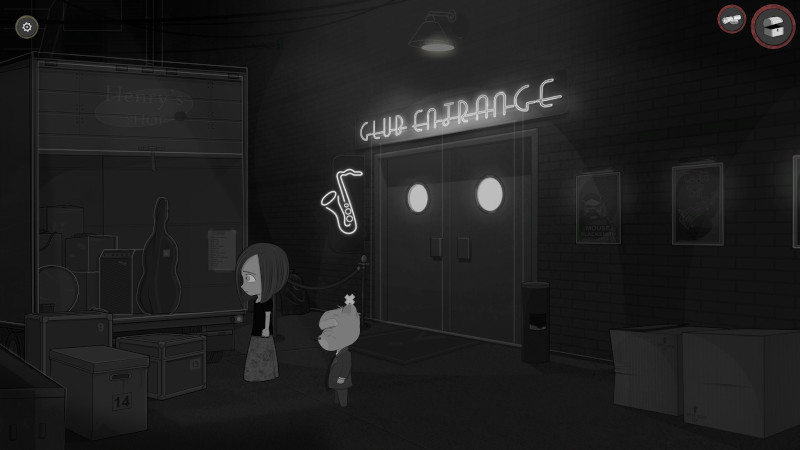
What’s going on with the lamp above the “Club Entrance” sign? Did a designer forget to remove an initial sketch from the final scene? (Credit: Exordium Games. Fair use.)
This kind of humor is difficult to pull off. For an example of masterful Fourth Wall breaking, see the Monkey Island “rubber tree” gag, or the Monkey Island 2 “hint line”. In both cases, the jokes are elaborate set pieces, and they occur after the player has spent hours immersing herself in the game world. In Bear With Me, you might encounter a silly developer joke in the third room.
This takes away from what is otherwise a richly textured (if mostly monochromatic) world, and is at odds with the game’s ambition to explore darker themes, especially in the final episode. There are a couple of other frustrations: Amber and Ted’s walk speeds are almost excruciatingly slow, which can get in the way of solving puzzles; while the art quality overall is high, some scenes are a bit sterile.
This is a plot-driven game, and you’re unlikely to need a walkthrough to make it past any of the game’s puzzles. Overall, I found the plot engaging, and would play another game in the series, if one existed. The three short episodes and the “Lost Robots” standalone episode add up to a medium-length adventure game.
I would give Bear With Me 3.5 stars, rounding down because of the rough edges, and because of neglect for the Linux version (The Lost Robots is only available for Windows, and Exordium’s developers don’t seem to be active in the Steam forums anymore; I was able to play the full game via Proton-GE). A good discount buy for point and click fans.
Die Spieleauswahl unter Linux ist leider immer noch sehr, sehr übersichtlich. Einige Spiele ragen heraus aber die große Auswahl besteht weiterhin auf Windowssystem. Die Verwaltung seiner Spiele unter Linux kann man mit lutris wesentlich bequemer gestalten. Wenn man denn die entsprechenden Vorbereitungen getroffen hat. Die Abhängigkeiten wie Grafiktreiber oder 7ZIP werden leider nicht durch das Programm installiert. Hier ist Handarbeit gefragt.
Verwaltung
Spiel suchen, klicken, installieren, spielen. Wenn es doch nur immer unter Linux so einfach wäre. So kann man dann auch aus dem umfangreichen Repertoire auswählen und drauf los spielen. Ich habe mir dieses Programm am Anfang nur installiert, um Session Seven zu spielen. Jedoch finde ich die Idee dahinter sehr charmant. So sinkt die Einstiegshürde von Linux bestimmt für einige Interessenten.

Screenshot der Spieleverwaltung Lutris unter Ubuntu (Eigenes Werk. Lizenz: CC-BY-SA.)
Verbesserungsbedarf
Neben den oben angesprochenen Punkten mit den zusätzlich zu installierenden Programm besteht bei den Sprachen nicht die Möglichkeit aus anderen Sprachen als Englisch auswählen zu können. Zudem ist die Bedienung nicht intuitiv. Man muss schon ein bisschen suchen und drauf los klicken.
Fazit
Wer unter Linux eine gute Möglichkeit sucht, seine Spiele zu verwalten ist mit Lutris eigentlich gut bedient. Diese offene Alternative hat sich zu den goldenen Käfigen der großen Anbieter gut in Stellung gebracht hat allerdings noch Luft nach oben
Schon wieder ein Point-and-Click-Adventure? Ja! Was soll man auch bei dem miesen Herbstwetter sonst machen? ;-) Mit Session Seven bekommt man ein gutes und kostenloses Adventure für Linux und Windows, welches für Linux auf der Spieleseite direkt herunterladbarer ist oder auch bei Lutris zur Verfügung steht. Auf letztgenannter Plattform ist das Spiel auch über Steam verfügbar.
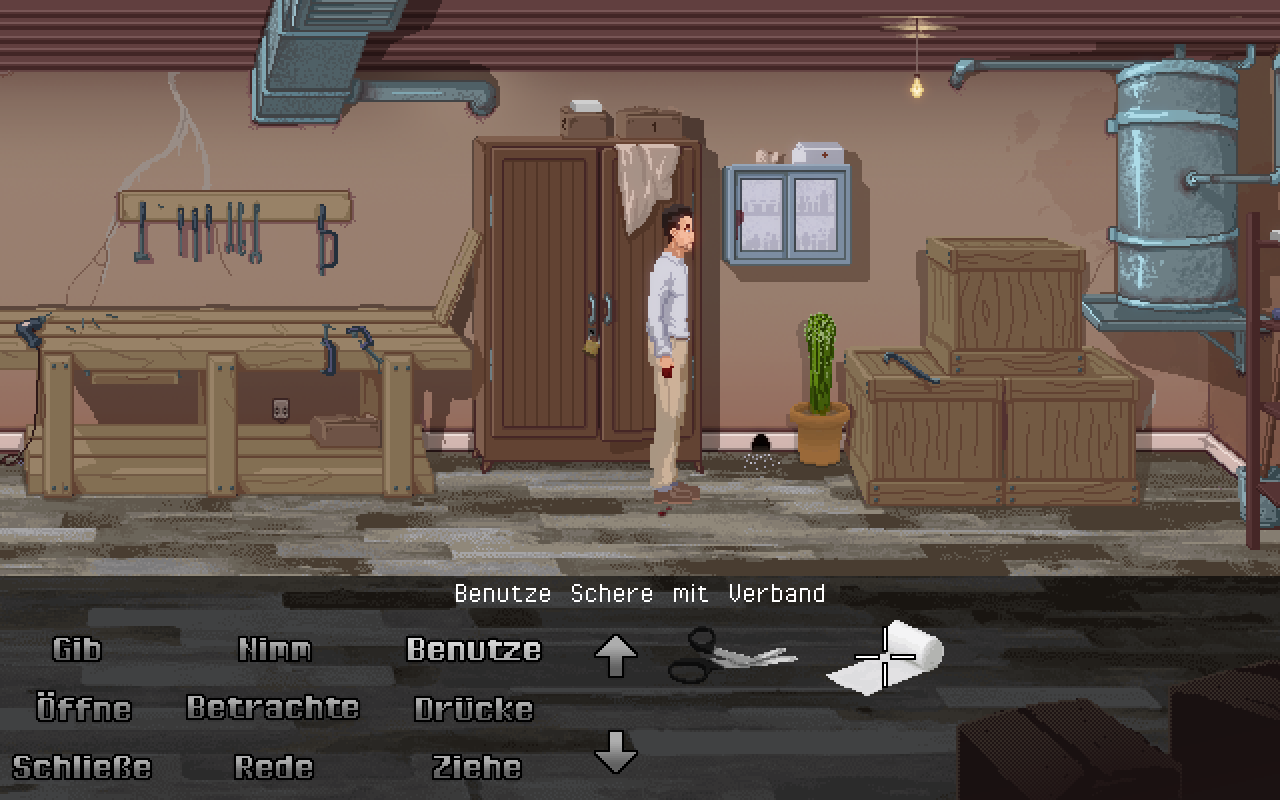
Ryan, nachdem er aufgewacht ist
Story
Du schlüpfst in die Rolle von Ryan, einem entfremdetem Vater und Ehemann, der verprügelt, verletzt und allein in einem verschlossenen Keller zu sich kommt. Dein Schädel brummt, und Du hast nur einige vage und verdrehte Erinnerungsfragmente darüber, wie Du hier gelandet bist. Ausgerüstet mit den wenigen Werkzeugen aus Deiner Umgebung und den seltsamen, teils finsteren Erinnerungen, die Du im Laufe des Spiels ins Gedächtnis zurückrufst, liegt es an Dir, herauszufinden was passiert ist, und aus dem Keller zu entkommen. (Quelle: https://www.sessionseven.com/de)
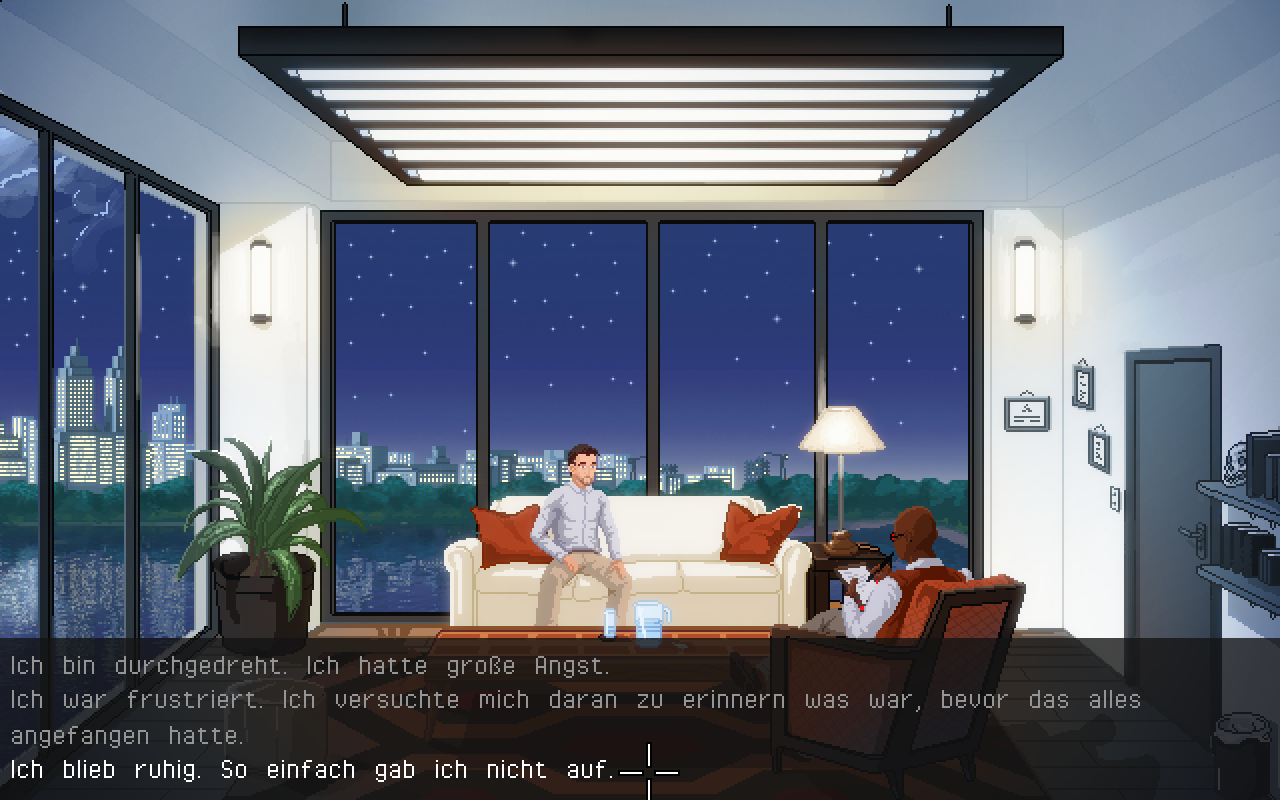
Fazit
Das Spiel ist eine tolle Unterhaltung für einen Nachmittag und nicht nur für Fans des Genres zu empfehlen. Es eignet sich vielmehr als Einstieg in diese Art des Adventurespiels. Man merkt im ganzen Spiel das die Freiwilligen hier sehr viel Liebe zum Detail haben einfließen lassen. Verfügbar ist das Spiel in Deutsch, Englisch und Spanisch. Ich kann allerdings nicht sagen ob bei der Übersetzung der Wortwitz des Originals abhanden gekommen ist.
